Facebook's Founder: A Report on Mark Zuckerberg's Entrepreneurship
VerifiedAdded on 2022/10/17
|38
|12206
|10
Report
AI Summary
This report examines the entrepreneurial journey of Mark Zuckerberg, focusing on his role as the founder of Facebook and the company's exceptional growth. It begins with a background on Zuckerberg's early interest in computer programming and his time at Harvard University, where he developed programs like FaceMash and CourseMatch. The paper then details the inception of Facebook, its rapid expansion, and Zuckerberg's transition from an entrepreneur to an executive. The report explores various aspects of Facebook's growth, including exceptional growth, intentional strategies, growth by design, growth through teams, duplication and franchising, internationalization, and business development. It highlights Zuckerberg's leadership style, his ability to adapt to managerial roles, and his focus on long-term objectives. The report also touches upon the challenges of scaling a business, including loyalty to comrades, task orientation, single-mindedness, and working in isolation. It concludes by summarizing Zuckerberg's contributions and the factors that contributed to Facebook's success, as well as his philanthropic endeavors. The report also references articles on growth strategies, entrepreneurial exit, and small business management. This analysis provides valuable insights into the entrepreneurial process and the strategies employed to build a global social media giant.
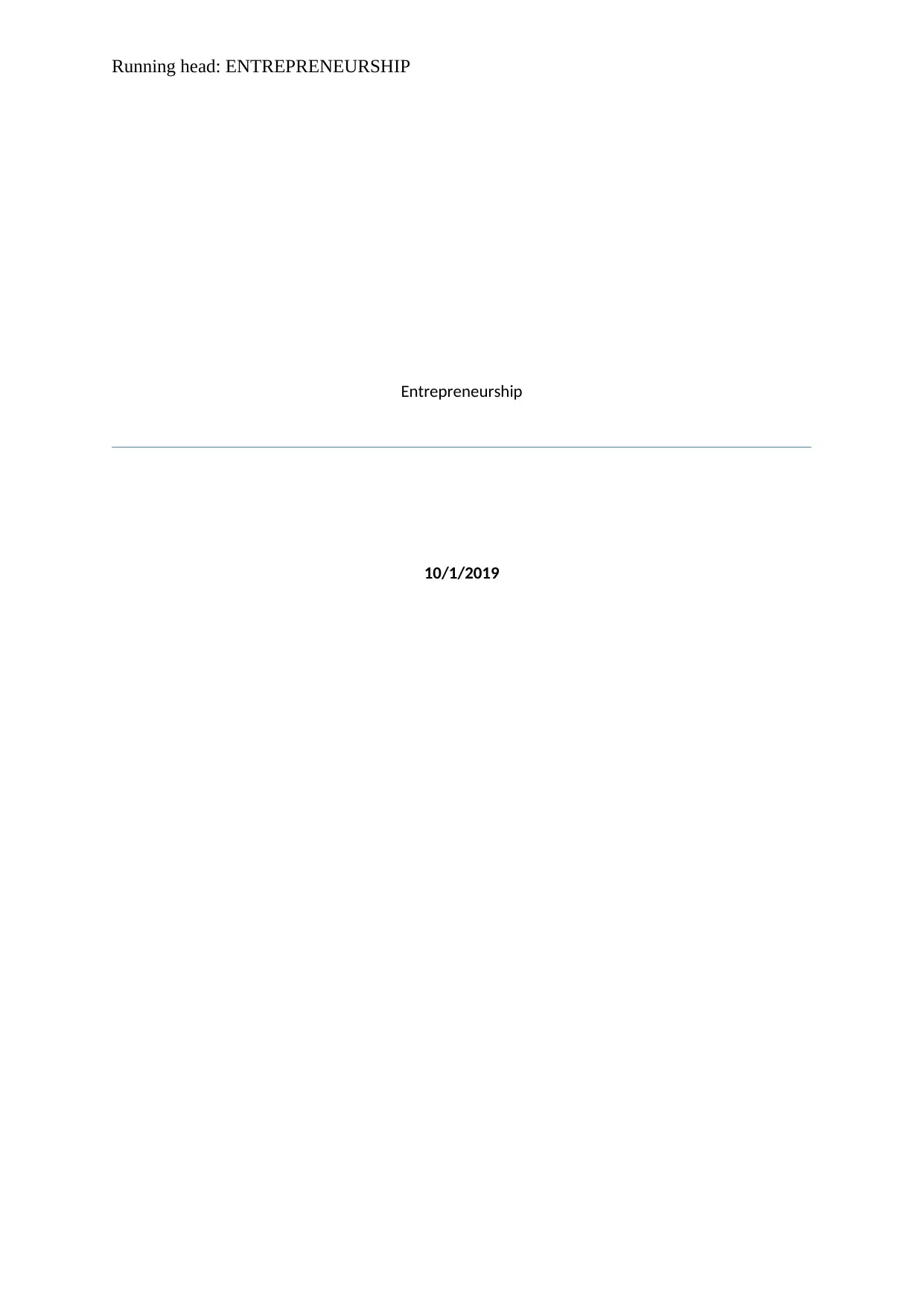
Running head: ENTREPRENEURSHIP
Entrepreneurship
10/1/2019
Entrepreneurship
10/1/2019
Paraphrase This Document
Need a fresh take? Get an instant paraphrase of this document with our AI Paraphraser
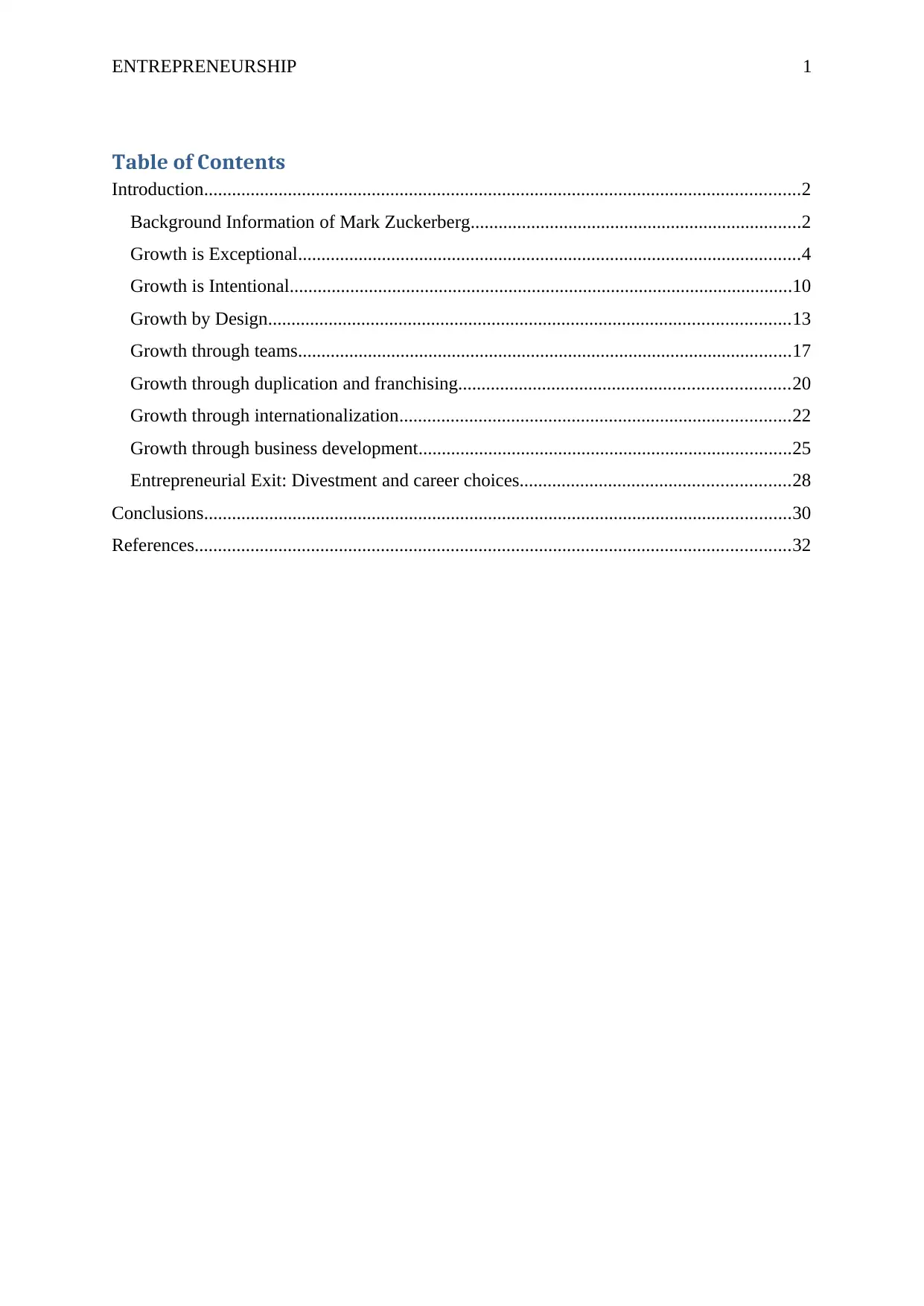
ENTREPRENEURSHIP 1
Table of Contents
Introduction................................................................................................................................2
Background Information of Mark Zuckerberg.......................................................................2
Growth is Exceptional............................................................................................................4
Growth is Intentional............................................................................................................10
Growth by Design................................................................................................................13
Growth through teams..........................................................................................................17
Growth through duplication and franchising.......................................................................20
Growth through internationalization....................................................................................22
Growth through business development................................................................................25
Entrepreneurial Exit: Divestment and career choices..........................................................28
Conclusions..............................................................................................................................30
References................................................................................................................................32
Table of Contents
Introduction................................................................................................................................2
Background Information of Mark Zuckerberg.......................................................................2
Growth is Exceptional............................................................................................................4
Growth is Intentional............................................................................................................10
Growth by Design................................................................................................................13
Growth through teams..........................................................................................................17
Growth through duplication and franchising.......................................................................20
Growth through internationalization....................................................................................22
Growth through business development................................................................................25
Entrepreneurial Exit: Divestment and career choices..........................................................28
Conclusions..............................................................................................................................30
References................................................................................................................................32
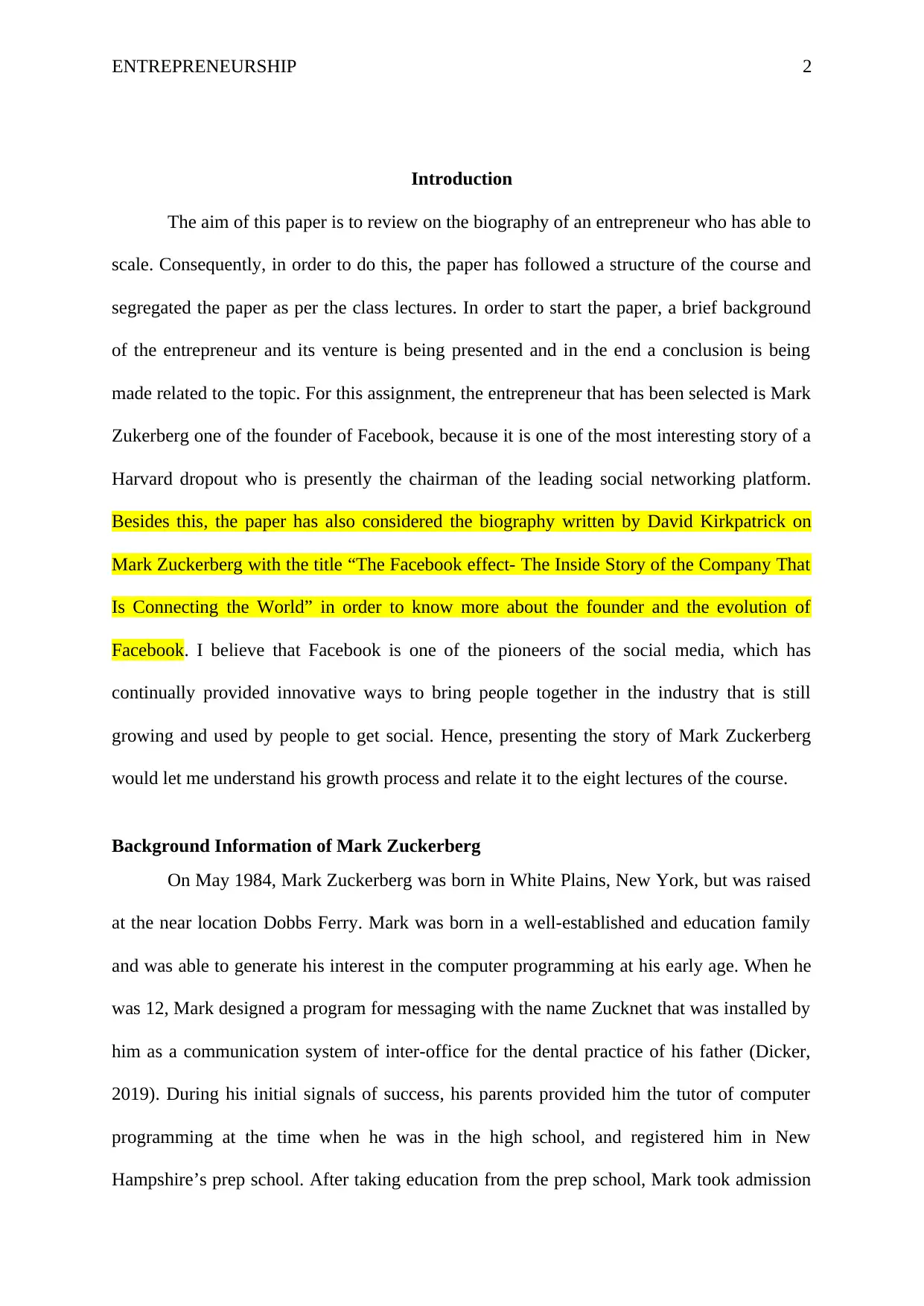
ENTREPRENEURSHIP 2
Introduction
The aim of this paper is to review on the biography of an entrepreneur who has able to
scale. Consequently, in order to do this, the paper has followed a structure of the course and
segregated the paper as per the class lectures. In order to start the paper, a brief background
of the entrepreneur and its venture is being presented and in the end a conclusion is being
made related to the topic. For this assignment, the entrepreneur that has been selected is Mark
Zukerberg one of the founder of Facebook, because it is one of the most interesting story of a
Harvard dropout who is presently the chairman of the leading social networking platform.
Besides this, the paper has also considered the biography written by David Kirkpatrick on
Mark Zuckerberg with the title “The Facebook effect- The Inside Story of the Company That
Is Connecting the World” in order to know more about the founder and the evolution of
Facebook. I believe that Facebook is one of the pioneers of the social media, which has
continually provided innovative ways to bring people together in the industry that is still
growing and used by people to get social. Hence, presenting the story of Mark Zuckerberg
would let me understand his growth process and relate it to the eight lectures of the course.
Background Information of Mark Zuckerberg
On May 1984, Mark Zuckerberg was born in White Plains, New York, but was raised
at the near location Dobbs Ferry. Mark was born in a well-established and education family
and was able to generate his interest in the computer programming at his early age. When he
was 12, Mark designed a program for messaging with the name Zucknet that was installed by
him as a communication system of inter-office for the dental practice of his father (Dicker,
2019). During his initial signals of success, his parents provided him the tutor of computer
programming at the time when he was in the high school, and registered him in New
Hampshire’s prep school. After taking education from the prep school, Mark took admission
Introduction
The aim of this paper is to review on the biography of an entrepreneur who has able to
scale. Consequently, in order to do this, the paper has followed a structure of the course and
segregated the paper as per the class lectures. In order to start the paper, a brief background
of the entrepreneur and its venture is being presented and in the end a conclusion is being
made related to the topic. For this assignment, the entrepreneur that has been selected is Mark
Zukerberg one of the founder of Facebook, because it is one of the most interesting story of a
Harvard dropout who is presently the chairman of the leading social networking platform.
Besides this, the paper has also considered the biography written by David Kirkpatrick on
Mark Zuckerberg with the title “The Facebook effect- The Inside Story of the Company That
Is Connecting the World” in order to know more about the founder and the evolution of
Facebook. I believe that Facebook is one of the pioneers of the social media, which has
continually provided innovative ways to bring people together in the industry that is still
growing and used by people to get social. Hence, presenting the story of Mark Zuckerberg
would let me understand his growth process and relate it to the eight lectures of the course.
Background Information of Mark Zuckerberg
On May 1984, Mark Zuckerberg was born in White Plains, New York, but was raised
at the near location Dobbs Ferry. Mark was born in a well-established and education family
and was able to generate his interest in the computer programming at his early age. When he
was 12, Mark designed a program for messaging with the name Zucknet that was installed by
him as a communication system of inter-office for the dental practice of his father (Dicker,
2019). During his initial signals of success, his parents provided him the tutor of computer
programming at the time when he was in the high school, and registered him in New
Hampshire’s prep school. After taking education from the prep school, Mark took admission
⊘ This is a preview!⊘
Do you want full access?
Subscribe today to unlock all pages.

Trusted by 1+ million students worldwide
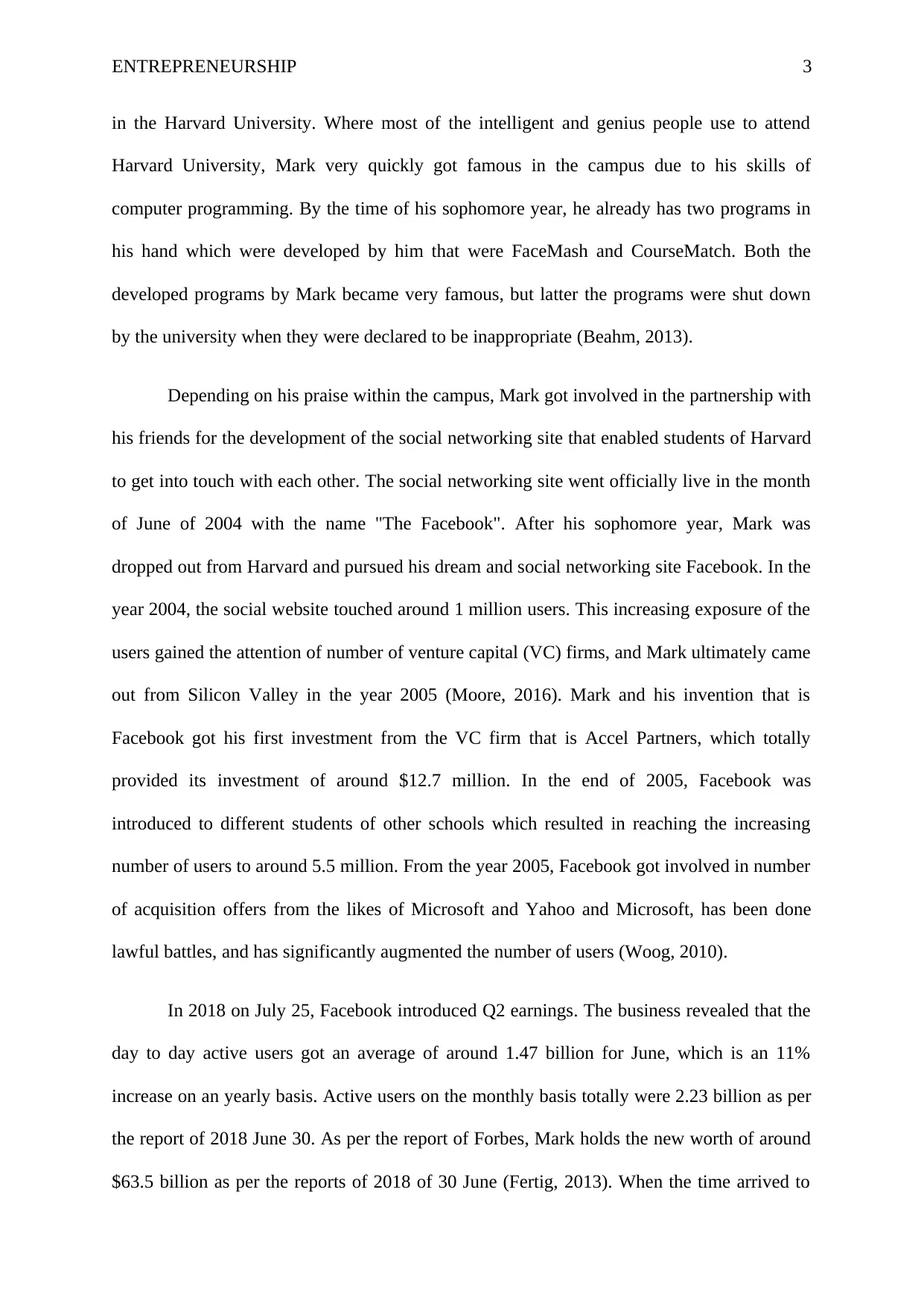
ENTREPRENEURSHIP 3
in the Harvard University. Where most of the intelligent and genius people use to attend
Harvard University, Mark very quickly got famous in the campus due to his skills of
computer programming. By the time of his sophomore year, he already has two programs in
his hand which were developed by him that were FaceMash and CourseMatch. Both the
developed programs by Mark became very famous, but latter the programs were shut down
by the university when they were declared to be inappropriate (Beahm, 2013).
Depending on his praise within the campus, Mark got involved in the partnership with
his friends for the development of the social networking site that enabled students of Harvard
to get into touch with each other. The social networking site went officially live in the month
of June of 2004 with the name "The Facebook". After his sophomore year, Mark was
dropped out from Harvard and pursued his dream and social networking site Facebook. In the
year 2004, the social website touched around 1 million users. This increasing exposure of the
users gained the attention of number of venture capital (VC) firms, and Mark ultimately came
out from Silicon Valley in the year 2005 (Moore, 2016). Mark and his invention that is
Facebook got his first investment from the VC firm that is Accel Partners, which totally
provided its investment of around $12.7 million. In the end of 2005, Facebook was
introduced to different students of other schools which resulted in reaching the increasing
number of users to around 5.5 million. From the year 2005, Facebook got involved in number
of acquisition offers from the likes of Microsoft and Yahoo and Microsoft, has been done
lawful battles, and has significantly augmented the number of users (Woog, 2010).
In 2018 on July 25, Facebook introduced Q2 earnings. The business revealed that the
day to day active users got an average of around 1.47 billion for June, which is an 11%
increase on an yearly basis. Active users on the monthly basis totally were 2.23 billion as per
the report of 2018 June 30. As per the report of Forbes, Mark holds the new worth of around
$63.5 billion as per the reports of 2018 of 30 June (Fertig, 2013). When the time arrived to
in the Harvard University. Where most of the intelligent and genius people use to attend
Harvard University, Mark very quickly got famous in the campus due to his skills of
computer programming. By the time of his sophomore year, he already has two programs in
his hand which were developed by him that were FaceMash and CourseMatch. Both the
developed programs by Mark became very famous, but latter the programs were shut down
by the university when they were declared to be inappropriate (Beahm, 2013).
Depending on his praise within the campus, Mark got involved in the partnership with
his friends for the development of the social networking site that enabled students of Harvard
to get into touch with each other. The social networking site went officially live in the month
of June of 2004 with the name "The Facebook". After his sophomore year, Mark was
dropped out from Harvard and pursued his dream and social networking site Facebook. In the
year 2004, the social website touched around 1 million users. This increasing exposure of the
users gained the attention of number of venture capital (VC) firms, and Mark ultimately came
out from Silicon Valley in the year 2005 (Moore, 2016). Mark and his invention that is
Facebook got his first investment from the VC firm that is Accel Partners, which totally
provided its investment of around $12.7 million. In the end of 2005, Facebook was
introduced to different students of other schools which resulted in reaching the increasing
number of users to around 5.5 million. From the year 2005, Facebook got involved in number
of acquisition offers from the likes of Microsoft and Yahoo and Microsoft, has been done
lawful battles, and has significantly augmented the number of users (Woog, 2010).
In 2018 on July 25, Facebook introduced Q2 earnings. The business revealed that the
day to day active users got an average of around 1.47 billion for June, which is an 11%
increase on an yearly basis. Active users on the monthly basis totally were 2.23 billion as per
the report of 2018 June 30. As per the report of Forbes, Mark holds the new worth of around
$63.5 billion as per the reports of 2018 of 30 June (Fertig, 2013). When the time arrived to
Paraphrase This Document
Need a fresh take? Get an instant paraphrase of this document with our AI Paraphraser
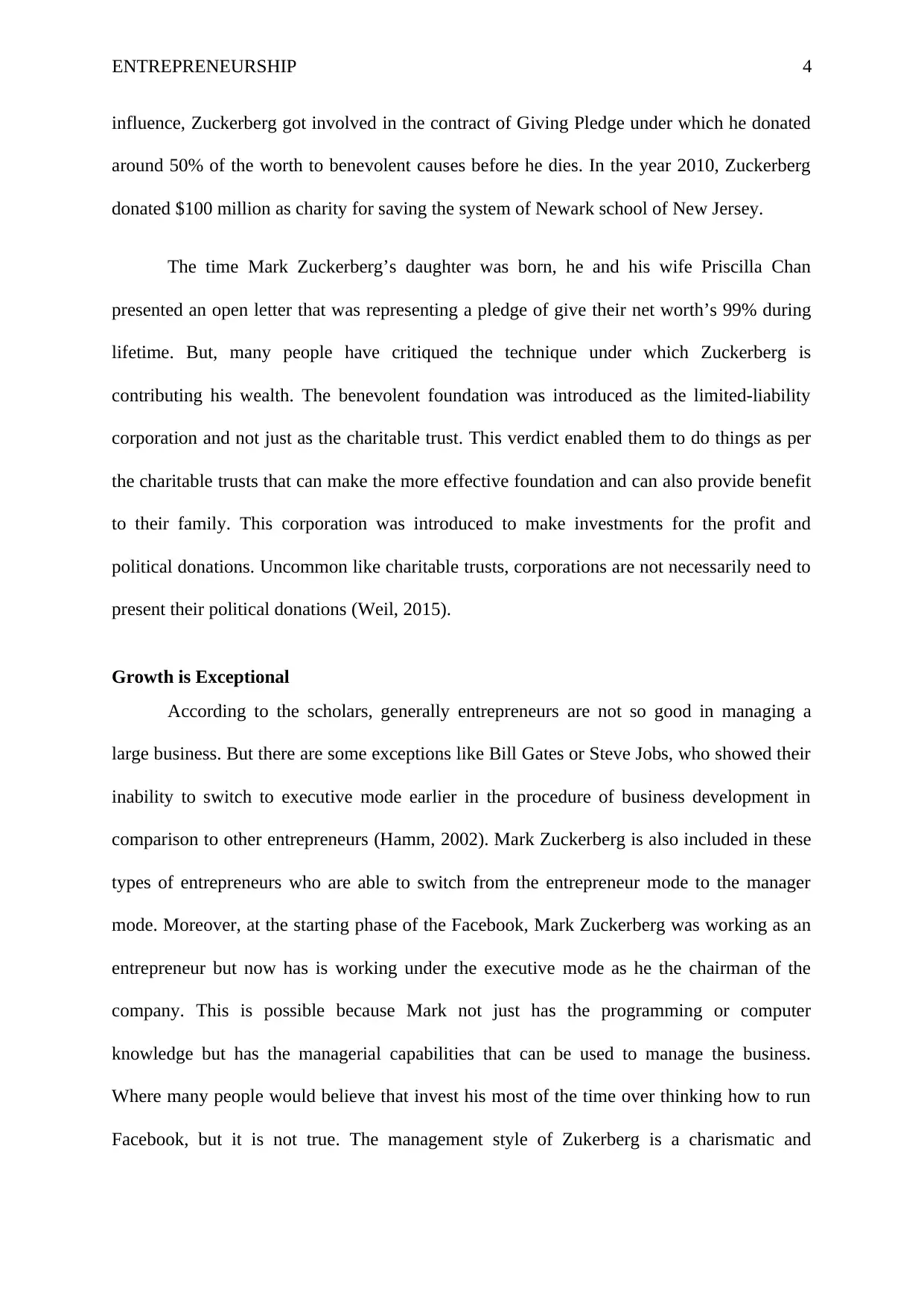
ENTREPRENEURSHIP 4
influence, Zuckerberg got involved in the contract of Giving Pledge under which he donated
around 50% of the worth to benevolent causes before he dies. In the year 2010, Zuckerberg
donated $100 million as charity for saving the system of Newark school of New Jersey.
The time Mark Zuckerberg’s daughter was born, he and his wife Priscilla Chan
presented an open letter that was representing a pledge of give their net worth’s 99% during
lifetime. But, many people have critiqued the technique under which Zuckerberg is
contributing his wealth. The benevolent foundation was introduced as the limited-liability
corporation and not just as the charitable trust. This verdict enabled them to do things as per
the charitable trusts that can make the more effective foundation and can also provide benefit
to their family. This corporation was introduced to make investments for the profit and
political donations. Uncommon like charitable trusts, corporations are not necessarily need to
present their political donations (Weil, 2015).
Growth is Exceptional
According to the scholars, generally entrepreneurs are not so good in managing a
large business. But there are some exceptions like Bill Gates or Steve Jobs, who showed their
inability to switch to executive mode earlier in the procedure of business development in
comparison to other entrepreneurs (Hamm, 2002). Mark Zuckerberg is also included in these
types of entrepreneurs who are able to switch from the entrepreneur mode to the manager
mode. Moreover, at the starting phase of the Facebook, Mark Zuckerberg was working as an
entrepreneur but now has is working under the executive mode as he the chairman of the
company. This is possible because Mark not just has the programming or computer
knowledge but has the managerial capabilities that can be used to manage the business.
Where many people would believe that invest his most of the time over thinking how to run
Facebook, but it is not true. The management style of Zukerberg is a charismatic and
influence, Zuckerberg got involved in the contract of Giving Pledge under which he donated
around 50% of the worth to benevolent causes before he dies. In the year 2010, Zuckerberg
donated $100 million as charity for saving the system of Newark school of New Jersey.
The time Mark Zuckerberg’s daughter was born, he and his wife Priscilla Chan
presented an open letter that was representing a pledge of give their net worth’s 99% during
lifetime. But, many people have critiqued the technique under which Zuckerberg is
contributing his wealth. The benevolent foundation was introduced as the limited-liability
corporation and not just as the charitable trust. This verdict enabled them to do things as per
the charitable trusts that can make the more effective foundation and can also provide benefit
to their family. This corporation was introduced to make investments for the profit and
political donations. Uncommon like charitable trusts, corporations are not necessarily need to
present their political donations (Weil, 2015).
Growth is Exceptional
According to the scholars, generally entrepreneurs are not so good in managing a
large business. But there are some exceptions like Bill Gates or Steve Jobs, who showed their
inability to switch to executive mode earlier in the procedure of business development in
comparison to other entrepreneurs (Hamm, 2002). Mark Zuckerberg is also included in these
types of entrepreneurs who are able to switch from the entrepreneur mode to the manager
mode. Moreover, at the starting phase of the Facebook, Mark Zuckerberg was working as an
entrepreneur but now has is working under the executive mode as he the chairman of the
company. This is possible because Mark not just has the programming or computer
knowledge but has the managerial capabilities that can be used to manage the business.
Where many people would believe that invest his most of the time over thinking how to run
Facebook, but it is not true. The management style of Zukerberg is a charismatic and
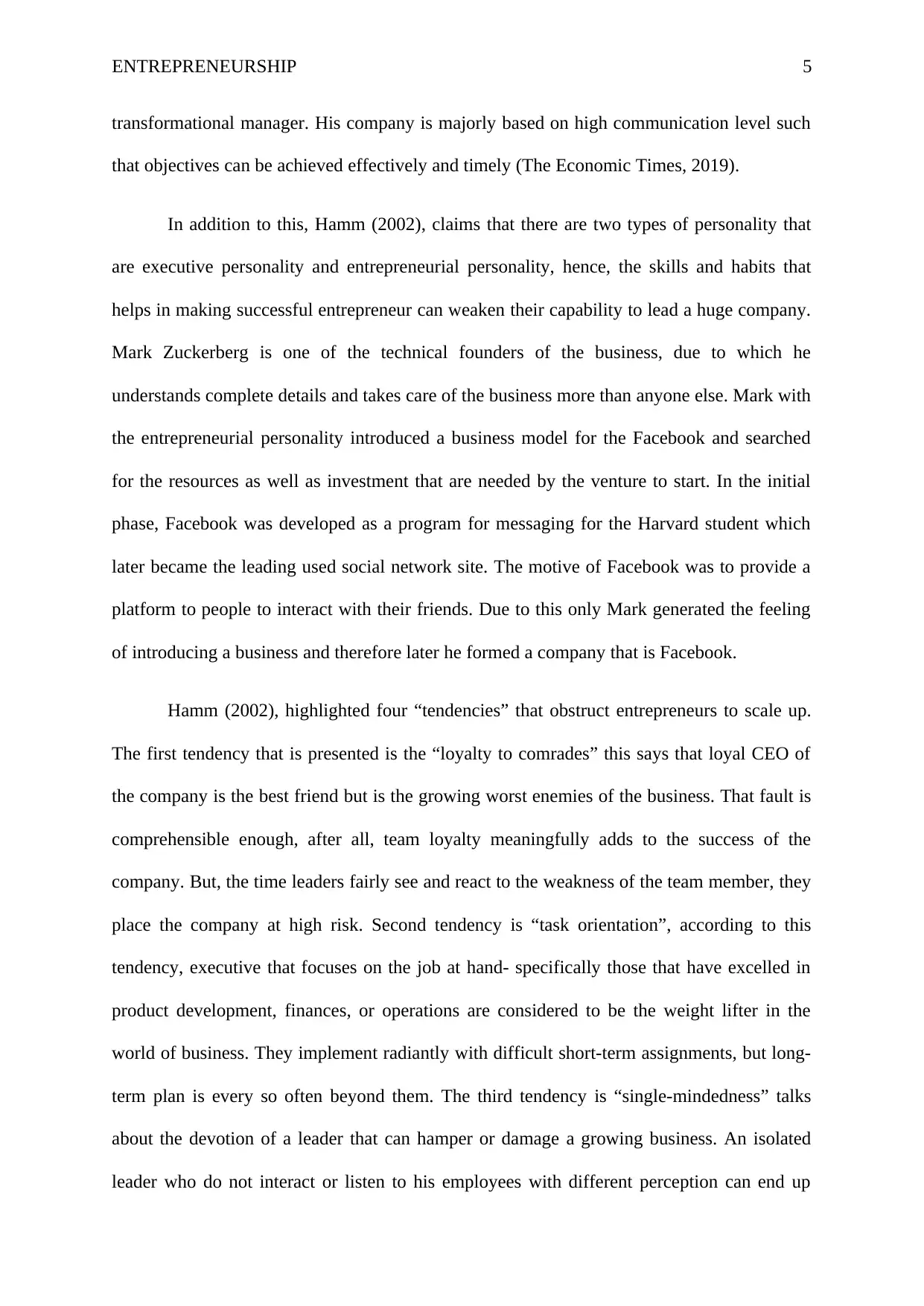
ENTREPRENEURSHIP 5
transformational manager. His company is majorly based on high communication level such
that objectives can be achieved effectively and timely (The Economic Times, 2019).
In addition to this, Hamm (2002), claims that there are two types of personality that
are executive personality and entrepreneurial personality, hence, the skills and habits that
helps in making successful entrepreneur can weaken their capability to lead a huge company.
Mark Zuckerberg is one of the technical founders of the business, due to which he
understands complete details and takes care of the business more than anyone else. Mark with
the entrepreneurial personality introduced a business model for the Facebook and searched
for the resources as well as investment that are needed by the venture to start. In the initial
phase, Facebook was developed as a program for messaging for the Harvard student which
later became the leading used social network site. The motive of Facebook was to provide a
platform to people to interact with their friends. Due to this only Mark generated the feeling
of introducing a business and therefore later he formed a company that is Facebook.
Hamm (2002), highlighted four “tendencies” that obstruct entrepreneurs to scale up.
The first tendency that is presented is the “loyalty to comrades” this says that loyal CEO of
the company is the best friend but is the growing worst enemies of the business. That fault is
comprehensible enough, after all, team loyalty meaningfully adds to the success of the
company. But, the time leaders fairly see and react to the weakness of the team member, they
place the company at high risk. Second tendency is “task orientation”, according to this
tendency, executive that focuses on the job at hand- specifically those that have excelled in
product development, finances, or operations are considered to be the weight lifter in the
world of business. They implement radiantly with difficult short-term assignments, but long-
term plan is every so often beyond them. The third tendency is “single-mindedness” talks
about the devotion of a leader that can hamper or damage a growing business. An isolated
leader who do not interact or listen to his employees with different perception can end up
transformational manager. His company is majorly based on high communication level such
that objectives can be achieved effectively and timely (The Economic Times, 2019).
In addition to this, Hamm (2002), claims that there are two types of personality that
are executive personality and entrepreneurial personality, hence, the skills and habits that
helps in making successful entrepreneur can weaken their capability to lead a huge company.
Mark Zuckerberg is one of the technical founders of the business, due to which he
understands complete details and takes care of the business more than anyone else. Mark with
the entrepreneurial personality introduced a business model for the Facebook and searched
for the resources as well as investment that are needed by the venture to start. In the initial
phase, Facebook was developed as a program for messaging for the Harvard student which
later became the leading used social network site. The motive of Facebook was to provide a
platform to people to interact with their friends. Due to this only Mark generated the feeling
of introducing a business and therefore later he formed a company that is Facebook.
Hamm (2002), highlighted four “tendencies” that obstruct entrepreneurs to scale up.
The first tendency that is presented is the “loyalty to comrades” this says that loyal CEO of
the company is the best friend but is the growing worst enemies of the business. That fault is
comprehensible enough, after all, team loyalty meaningfully adds to the success of the
company. But, the time leaders fairly see and react to the weakness of the team member, they
place the company at high risk. Second tendency is “task orientation”, according to this
tendency, executive that focuses on the job at hand- specifically those that have excelled in
product development, finances, or operations are considered to be the weight lifter in the
world of business. They implement radiantly with difficult short-term assignments, but long-
term plan is every so often beyond them. The third tendency is “single-mindedness” talks
about the devotion of a leader that can hamper or damage a growing business. An isolated
leader who do not interact or listen to his employees with different perception can end up
⊘ This is a preview!⊘
Do you want full access?
Subscribe today to unlock all pages.

Trusted by 1+ million students worldwide
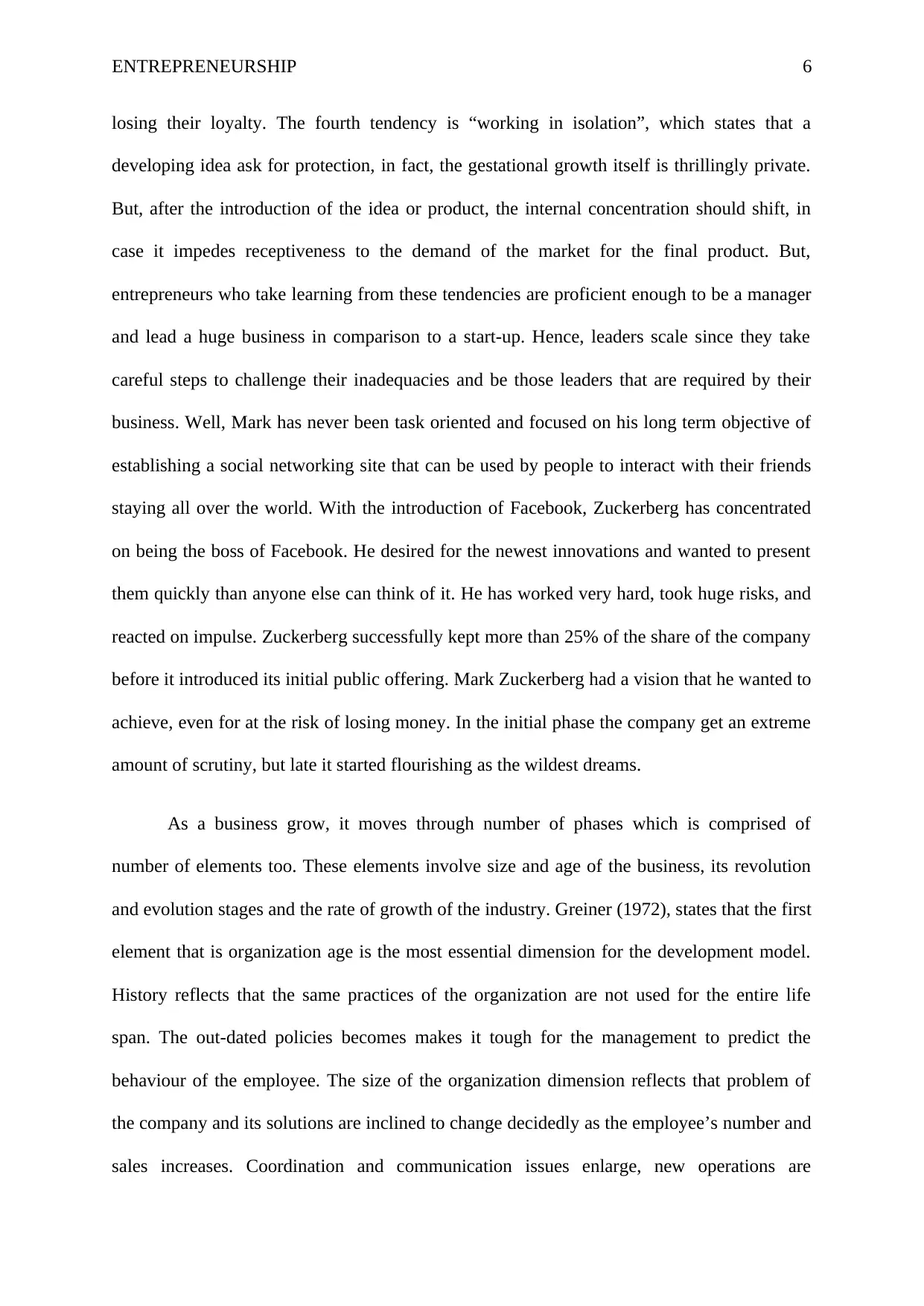
ENTREPRENEURSHIP 6
losing their loyalty. The fourth tendency is “working in isolation”, which states that a
developing idea ask for protection, in fact, the gestational growth itself is thrillingly private.
But, after the introduction of the idea or product, the internal concentration should shift, in
case it impedes receptiveness to the demand of the market for the final product. But,
entrepreneurs who take learning from these tendencies are proficient enough to be a manager
and lead a huge business in comparison to a start-up. Hence, leaders scale since they take
careful steps to challenge their inadequacies and be those leaders that are required by their
business. Well, Mark has never been task oriented and focused on his long term objective of
establishing a social networking site that can be used by people to interact with their friends
staying all over the world. With the introduction of Facebook, Zuckerberg has concentrated
on being the boss of Facebook. He desired for the newest innovations and wanted to present
them quickly than anyone else can think of it. He has worked very hard, took huge risks, and
reacted on impulse. Zuckerberg successfully kept more than 25% of the share of the company
before it introduced its initial public offering. Mark Zuckerberg had a vision that he wanted to
achieve, even for at the risk of losing money. In the initial phase the company get an extreme
amount of scrutiny, but late it started flourishing as the wildest dreams.
As a business grow, it moves through number of phases which is comprised of
number of elements too. These elements involve size and age of the business, its revolution
and evolution stages and the rate of growth of the industry. Greiner (1972), states that the first
element that is organization age is the most essential dimension for the development model.
History reflects that the same practices of the organization are not used for the entire life
span. The out-dated policies becomes makes it tough for the management to predict the
behaviour of the employee. The size of the organization dimension reflects that problem of
the company and its solutions are inclined to change decidedly as the employee’s number and
sales increases. Coordination and communication issues enlarge, new operations are
losing their loyalty. The fourth tendency is “working in isolation”, which states that a
developing idea ask for protection, in fact, the gestational growth itself is thrillingly private.
But, after the introduction of the idea or product, the internal concentration should shift, in
case it impedes receptiveness to the demand of the market for the final product. But,
entrepreneurs who take learning from these tendencies are proficient enough to be a manager
and lead a huge business in comparison to a start-up. Hence, leaders scale since they take
careful steps to challenge their inadequacies and be those leaders that are required by their
business. Well, Mark has never been task oriented and focused on his long term objective of
establishing a social networking site that can be used by people to interact with their friends
staying all over the world. With the introduction of Facebook, Zuckerberg has concentrated
on being the boss of Facebook. He desired for the newest innovations and wanted to present
them quickly than anyone else can think of it. He has worked very hard, took huge risks, and
reacted on impulse. Zuckerberg successfully kept more than 25% of the share of the company
before it introduced its initial public offering. Mark Zuckerberg had a vision that he wanted to
achieve, even for at the risk of losing money. In the initial phase the company get an extreme
amount of scrutiny, but late it started flourishing as the wildest dreams.
As a business grow, it moves through number of phases which is comprised of
number of elements too. These elements involve size and age of the business, its revolution
and evolution stages and the rate of growth of the industry. Greiner (1972), states that the first
element that is organization age is the most essential dimension for the development model.
History reflects that the same practices of the organization are not used for the entire life
span. The out-dated policies becomes makes it tough for the management to predict the
behaviour of the employee. The size of the organization dimension reflects that problem of
the company and its solutions are inclined to change decidedly as the employee’s number and
sales increases. Coordination and communication issues enlarge, new operations are
Paraphrase This Document
Need a fresh take? Get an instant paraphrase of this document with our AI Paraphraser
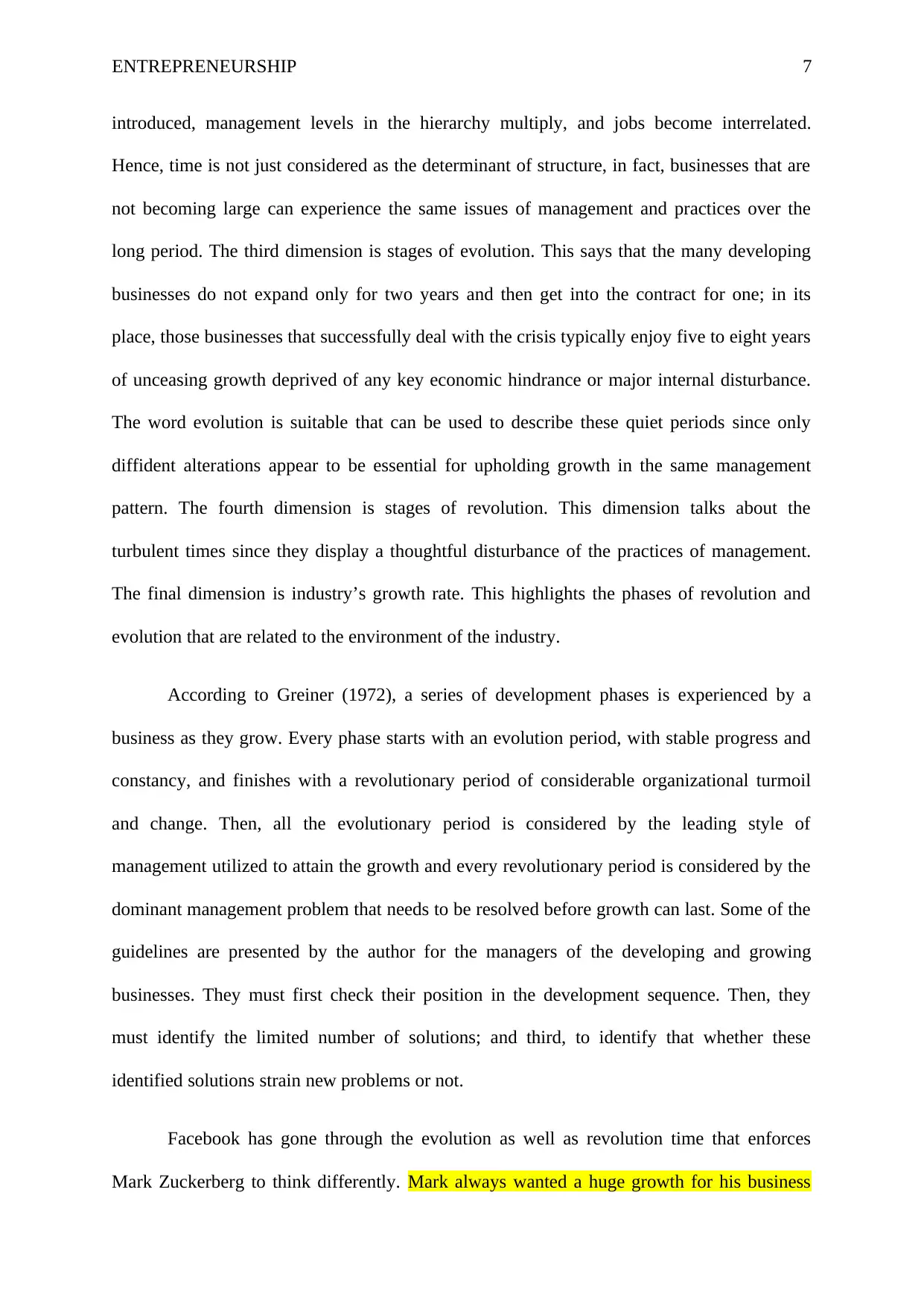
ENTREPRENEURSHIP 7
introduced, management levels in the hierarchy multiply, and jobs become interrelated.
Hence, time is not just considered as the determinant of structure, in fact, businesses that are
not becoming large can experience the same issues of management and practices over the
long period. The third dimension is stages of evolution. This says that the many developing
businesses do not expand only for two years and then get into the contract for one; in its
place, those businesses that successfully deal with the crisis typically enjoy five to eight years
of unceasing growth deprived of any key economic hindrance or major internal disturbance.
The word evolution is suitable that can be used to describe these quiet periods since only
diffident alterations appear to be essential for upholding growth in the same management
pattern. The fourth dimension is stages of revolution. This dimension talks about the
turbulent times since they display a thoughtful disturbance of the practices of management.
The final dimension is industry’s growth rate. This highlights the phases of revolution and
evolution that are related to the environment of the industry.
According to Greiner (1972), a series of development phases is experienced by a
business as they grow. Every phase starts with an evolution period, with stable progress and
constancy, and finishes with a revolutionary period of considerable organizational turmoil
and change. Then, all the evolutionary period is considered by the leading style of
management utilized to attain the growth and every revolutionary period is considered by the
dominant management problem that needs to be resolved before growth can last. Some of the
guidelines are presented by the author for the managers of the developing and growing
businesses. They must first check their position in the development sequence. Then, they
must identify the limited number of solutions; and third, to identify that whether these
identified solutions strain new problems or not.
Facebook has gone through the evolution as well as revolution time that enforces
Mark Zuckerberg to think differently. Mark always wanted a huge growth for his business
introduced, management levels in the hierarchy multiply, and jobs become interrelated.
Hence, time is not just considered as the determinant of structure, in fact, businesses that are
not becoming large can experience the same issues of management and practices over the
long period. The third dimension is stages of evolution. This says that the many developing
businesses do not expand only for two years and then get into the contract for one; in its
place, those businesses that successfully deal with the crisis typically enjoy five to eight years
of unceasing growth deprived of any key economic hindrance or major internal disturbance.
The word evolution is suitable that can be used to describe these quiet periods since only
diffident alterations appear to be essential for upholding growth in the same management
pattern. The fourth dimension is stages of revolution. This dimension talks about the
turbulent times since they display a thoughtful disturbance of the practices of management.
The final dimension is industry’s growth rate. This highlights the phases of revolution and
evolution that are related to the environment of the industry.
According to Greiner (1972), a series of development phases is experienced by a
business as they grow. Every phase starts with an evolution period, with stable progress and
constancy, and finishes with a revolutionary period of considerable organizational turmoil
and change. Then, all the evolutionary period is considered by the leading style of
management utilized to attain the growth and every revolutionary period is considered by the
dominant management problem that needs to be resolved before growth can last. Some of the
guidelines are presented by the author for the managers of the developing and growing
businesses. They must first check their position in the development sequence. Then, they
must identify the limited number of solutions; and third, to identify that whether these
identified solutions strain new problems or not.
Facebook has gone through the evolution as well as revolution time that enforces
Mark Zuckerberg to think differently. Mark always wanted a huge growth for his business
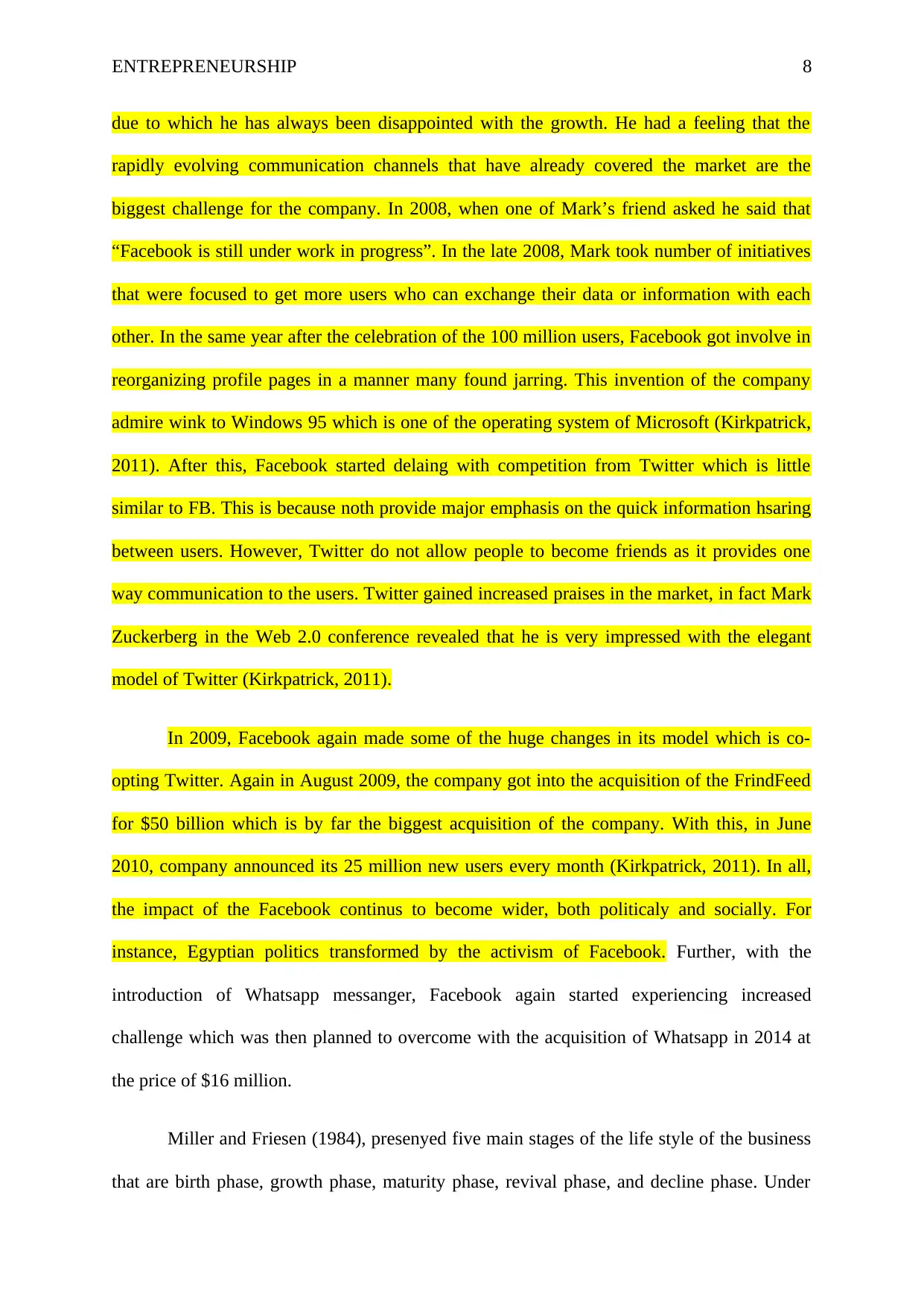
ENTREPRENEURSHIP 8
due to which he has always been disappointed with the growth. He had a feeling that the
rapidly evolving communication channels that have already covered the market are the
biggest challenge for the company. In 2008, when one of Mark’s friend asked he said that
“Facebook is still under work in progress”. In the late 2008, Mark took number of initiatives
that were focused to get more users who can exchange their data or information with each
other. In the same year after the celebration of the 100 million users, Facebook got involve in
reorganizing profile pages in a manner many found jarring. This invention of the company
admire wink to Windows 95 which is one of the operating system of Microsoft (Kirkpatrick,
2011). After this, Facebook started delaing with competition from Twitter which is little
similar to FB. This is because noth provide major emphasis on the quick information hsaring
between users. However, Twitter do not allow people to become friends as it provides one
way communication to the users. Twitter gained increased praises in the market, in fact Mark
Zuckerberg in the Web 2.0 conference revealed that he is very impressed with the elegant
model of Twitter (Kirkpatrick, 2011).
In 2009, Facebook again made some of the huge changes in its model which is co-
opting Twitter. Again in August 2009, the company got into the acquisition of the FrindFeed
for $50 billion which is by far the biggest acquisition of the company. With this, in June
2010, company announced its 25 million new users every month (Kirkpatrick, 2011). In all,
the impact of the Facebook continus to become wider, both politicaly and socially. For
instance, Egyptian politics transformed by the activism of Facebook. Further, with the
introduction of Whatsapp messanger, Facebook again started experiencing increased
challenge which was then planned to overcome with the acquisition of Whatsapp in 2014 at
the price of $16 million.
Miller and Friesen (1984), presenyed five main stages of the life style of the business
that are birth phase, growth phase, maturity phase, revival phase, and decline phase. Under
due to which he has always been disappointed with the growth. He had a feeling that the
rapidly evolving communication channels that have already covered the market are the
biggest challenge for the company. In 2008, when one of Mark’s friend asked he said that
“Facebook is still under work in progress”. In the late 2008, Mark took number of initiatives
that were focused to get more users who can exchange their data or information with each
other. In the same year after the celebration of the 100 million users, Facebook got involve in
reorganizing profile pages in a manner many found jarring. This invention of the company
admire wink to Windows 95 which is one of the operating system of Microsoft (Kirkpatrick,
2011). After this, Facebook started delaing with competition from Twitter which is little
similar to FB. This is because noth provide major emphasis on the quick information hsaring
between users. However, Twitter do not allow people to become friends as it provides one
way communication to the users. Twitter gained increased praises in the market, in fact Mark
Zuckerberg in the Web 2.0 conference revealed that he is very impressed with the elegant
model of Twitter (Kirkpatrick, 2011).
In 2009, Facebook again made some of the huge changes in its model which is co-
opting Twitter. Again in August 2009, the company got into the acquisition of the FrindFeed
for $50 billion which is by far the biggest acquisition of the company. With this, in June
2010, company announced its 25 million new users every month (Kirkpatrick, 2011). In all,
the impact of the Facebook continus to become wider, both politicaly and socially. For
instance, Egyptian politics transformed by the activism of Facebook. Further, with the
introduction of Whatsapp messanger, Facebook again started experiencing increased
challenge which was then planned to overcome with the acquisition of Whatsapp in 2014 at
the price of $16 million.
Miller and Friesen (1984), presenyed five main stages of the life style of the business
that are birth phase, growth phase, maturity phase, revival phase, and decline phase. Under
⊘ This is a preview!⊘
Do you want full access?
Subscribe today to unlock all pages.

Trusted by 1+ million students worldwide
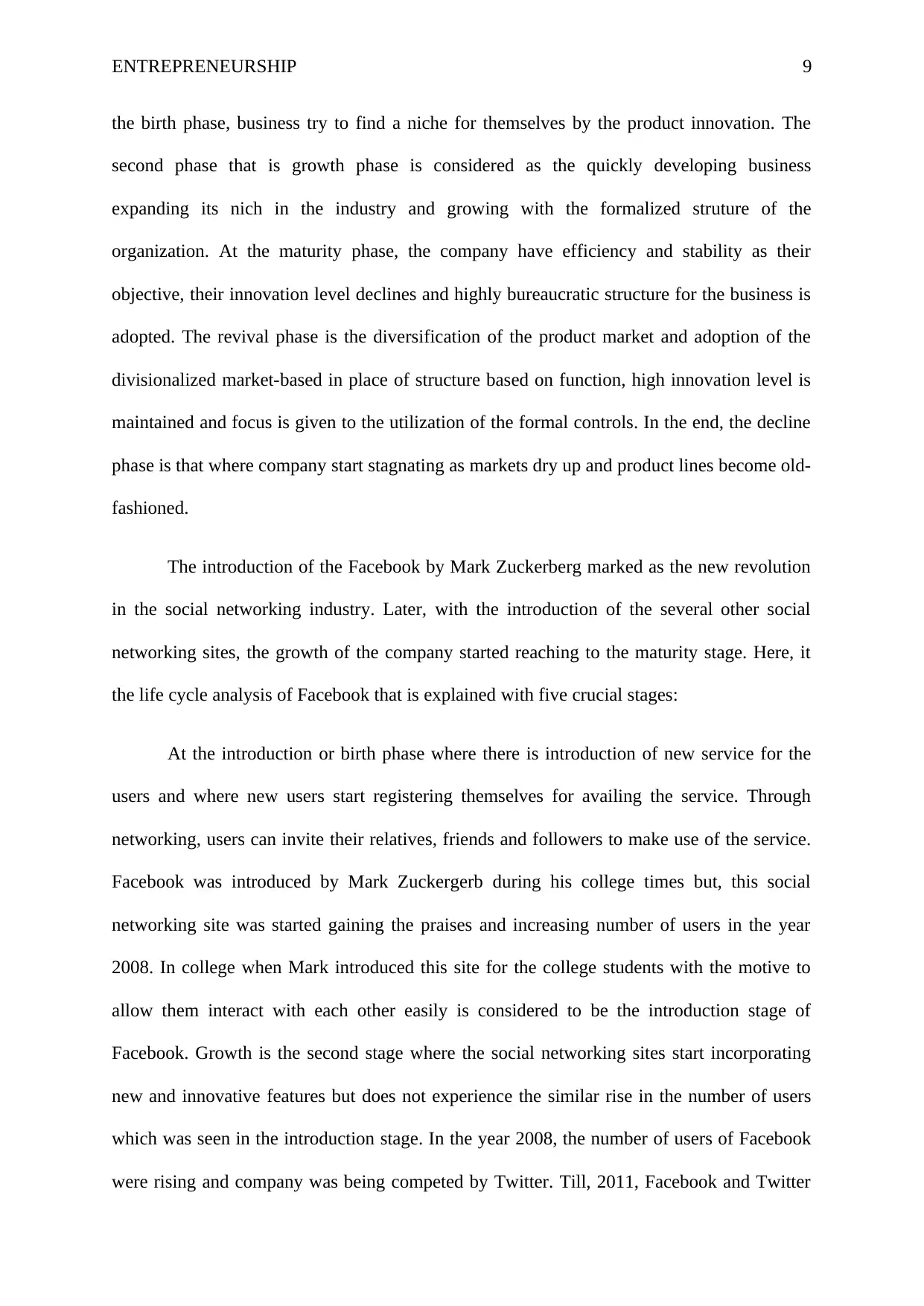
ENTREPRENEURSHIP 9
the birth phase, business try to find a niche for themselves by the product innovation. The
second phase that is growth phase is considered as the quickly developing business
expanding its nich in the industry and growing with the formalized struture of the
organization. At the maturity phase, the company have efficiency and stability as their
objective, their innovation level declines and highly bureaucratic structure for the business is
adopted. The revival phase is the diversification of the product market and adoption of the
divisionalized market-based in place of structure based on function, high innovation level is
maintained and focus is given to the utilization of the formal controls. In the end, the decline
phase is that where company start stagnating as markets dry up and product lines become old-
fashioned.
The introduction of the Facebook by Mark Zuckerberg marked as the new revolution
in the social networking industry. Later, with the introduction of the several other social
networking sites, the growth of the company started reaching to the maturity stage. Here, it
the life cycle analysis of Facebook that is explained with five crucial stages:
At the introduction or birth phase where there is introduction of new service for the
users and where new users start registering themselves for availing the service. Through
networking, users can invite their relatives, friends and followers to make use of the service.
Facebook was introduced by Mark Zuckergerb during his college times but, this social
networking site was started gaining the praises and increasing number of users in the year
2008. In college when Mark introduced this site for the college students with the motive to
allow them interact with each other easily is considered to be the introduction stage of
Facebook. Growth is the second stage where the social networking sites start incorporating
new and innovative features but does not experience the similar rise in the number of users
which was seen in the introduction stage. In the year 2008, the number of users of Facebook
were rising and company was being competed by Twitter. Till, 2011, Facebook and Twitter
the birth phase, business try to find a niche for themselves by the product innovation. The
second phase that is growth phase is considered as the quickly developing business
expanding its nich in the industry and growing with the formalized struture of the
organization. At the maturity phase, the company have efficiency and stability as their
objective, their innovation level declines and highly bureaucratic structure for the business is
adopted. The revival phase is the diversification of the product market and adoption of the
divisionalized market-based in place of structure based on function, high innovation level is
maintained and focus is given to the utilization of the formal controls. In the end, the decline
phase is that where company start stagnating as markets dry up and product lines become old-
fashioned.
The introduction of the Facebook by Mark Zuckerberg marked as the new revolution
in the social networking industry. Later, with the introduction of the several other social
networking sites, the growth of the company started reaching to the maturity stage. Here, it
the life cycle analysis of Facebook that is explained with five crucial stages:
At the introduction or birth phase where there is introduction of new service for the
users and where new users start registering themselves for availing the service. Through
networking, users can invite their relatives, friends and followers to make use of the service.
Facebook was introduced by Mark Zuckergerb during his college times but, this social
networking site was started gaining the praises and increasing number of users in the year
2008. In college when Mark introduced this site for the college students with the motive to
allow them interact with each other easily is considered to be the introduction stage of
Facebook. Growth is the second stage where the social networking sites start incorporating
new and innovative features but does not experience the similar rise in the number of users
which was seen in the introduction stage. In the year 2008, the number of users of Facebook
were rising and company was being competed by Twitter. Till, 2011, Facebook and Twitter
Paraphrase This Document
Need a fresh take? Get an instant paraphrase of this document with our AI Paraphraser
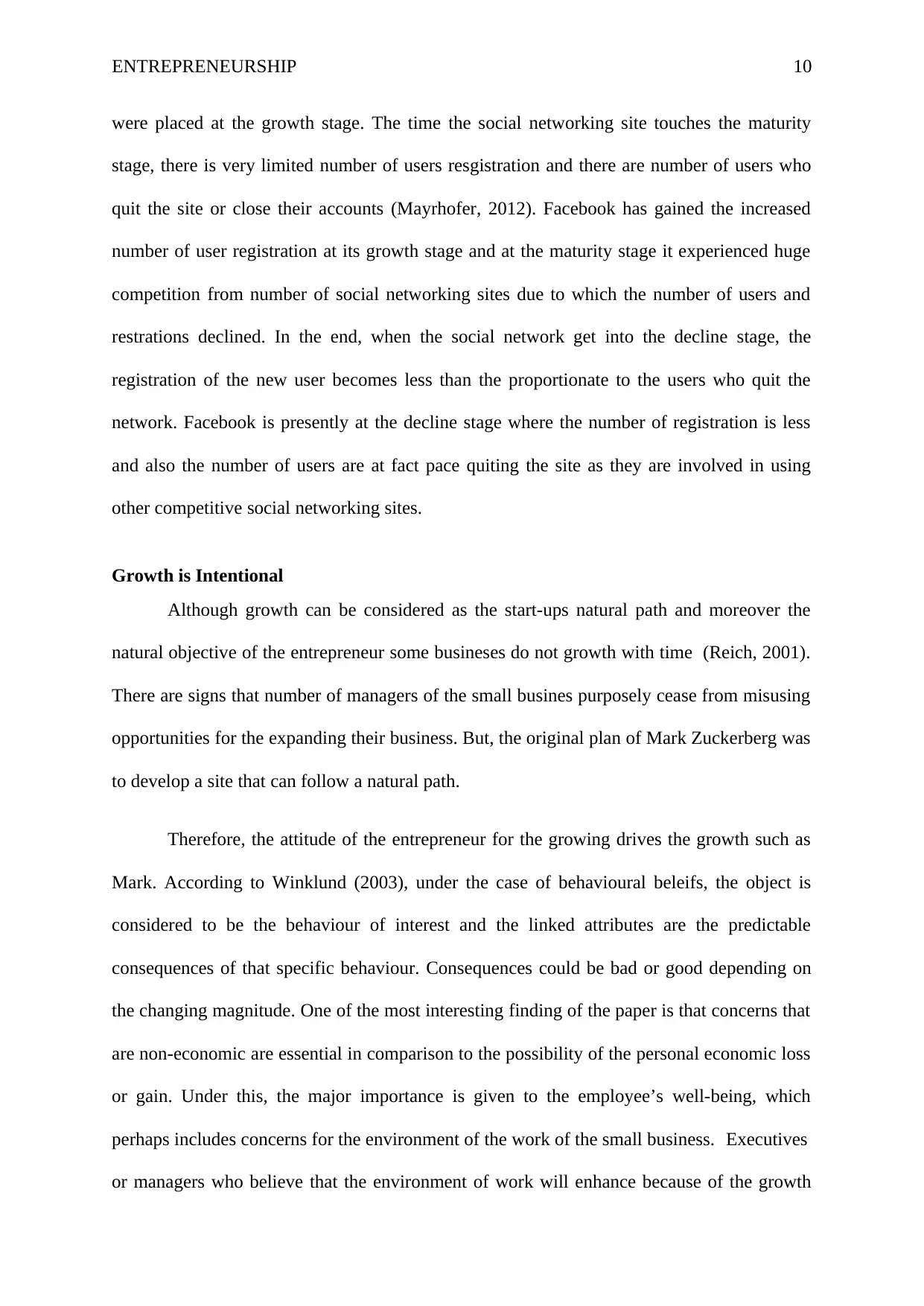
ENTREPRENEURSHIP 10
were placed at the growth stage. The time the social networking site touches the maturity
stage, there is very limited number of users resgistration and there are number of users who
quit the site or close their accounts (Mayrhofer, 2012). Facebook has gained the increased
number of user registration at its growth stage and at the maturity stage it experienced huge
competition from number of social networking sites due to which the number of users and
restrations declined. In the end, when the social network get into the decline stage, the
registration of the new user becomes less than the proportionate to the users who quit the
network. Facebook is presently at the decline stage where the number of registration is less
and also the number of users are at fact pace quiting the site as they are involved in using
other competitive social networking sites.
Growth is Intentional
Although growth can be considered as the start-ups natural path and moreover the
natural objective of the entrepreneur some busineses do not growth with time (Reich, 2001).
There are signs that number of managers of the small busines purposely cease from misusing
opportunities for the expanding their business. But, the original plan of Mark Zuckerberg was
to develop a site that can follow a natural path.
Therefore, the attitude of the entrepreneur for the growing drives the growth such as
Mark. According to Winklund (2003), under the case of behavioural beleifs, the object is
considered to be the behaviour of interest and the linked attributes are the predictable
consequences of that specific behaviour. Consequences could be bad or good depending on
the changing magnitude. One of the most interesting finding of the paper is that concerns that
are non-economic are essential in comparison to the possibility of the personal economic loss
or gain. Under this, the major importance is given to the employee’s well-being, which
perhaps includes concerns for the environment of the work of the small business. Executives
or managers who believe that the environment of work will enhance because of the growth
were placed at the growth stage. The time the social networking site touches the maturity
stage, there is very limited number of users resgistration and there are number of users who
quit the site or close their accounts (Mayrhofer, 2012). Facebook has gained the increased
number of user registration at its growth stage and at the maturity stage it experienced huge
competition from number of social networking sites due to which the number of users and
restrations declined. In the end, when the social network get into the decline stage, the
registration of the new user becomes less than the proportionate to the users who quit the
network. Facebook is presently at the decline stage where the number of registration is less
and also the number of users are at fact pace quiting the site as they are involved in using
other competitive social networking sites.
Growth is Intentional
Although growth can be considered as the start-ups natural path and moreover the
natural objective of the entrepreneur some busineses do not growth with time (Reich, 2001).
There are signs that number of managers of the small busines purposely cease from misusing
opportunities for the expanding their business. But, the original plan of Mark Zuckerberg was
to develop a site that can follow a natural path.
Therefore, the attitude of the entrepreneur for the growing drives the growth such as
Mark. According to Winklund (2003), under the case of behavioural beleifs, the object is
considered to be the behaviour of interest and the linked attributes are the predictable
consequences of that specific behaviour. Consequences could be bad or good depending on
the changing magnitude. One of the most interesting finding of the paper is that concerns that
are non-economic are essential in comparison to the possibility of the personal economic loss
or gain. Under this, the major importance is given to the employee’s well-being, which
perhaps includes concerns for the environment of the work of the small business. Executives
or managers who believe that the environment of work will enhance because of the growth
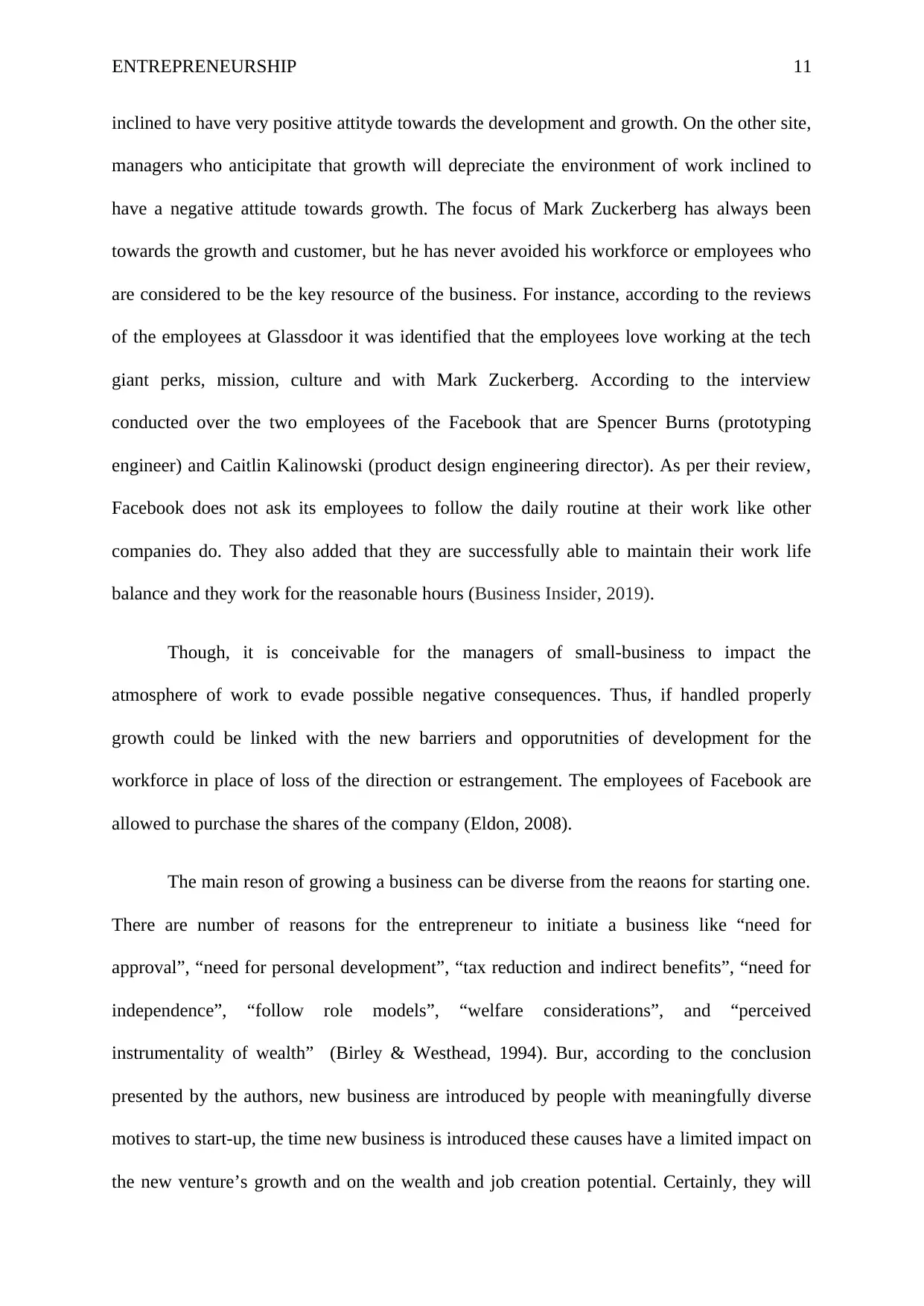
ENTREPRENEURSHIP 11
inclined to have very positive attityde towards the development and growth. On the other site,
managers who anticipitate that growth will depreciate the environment of work inclined to
have a negative attitude towards growth. The focus of Mark Zuckerberg has always been
towards the growth and customer, but he has never avoided his workforce or employees who
are considered to be the key resource of the business. For instance, according to the reviews
of the employees at Glassdoor it was identified that the employees love working at the tech
giant perks, mission, culture and with Mark Zuckerberg. According to the interview
conducted over the two employees of the Facebook that are Spencer Burns (prototyping
engineer) and Caitlin Kalinowski (product design engineering director). As per their review,
Facebook does not ask its employees to follow the daily routine at their work like other
companies do. They also added that they are successfully able to maintain their work life
balance and they work for the reasonable hours (Business Insider, 2019).
Though, it is conceivable for the managers of small-business to impact the
atmosphere of work to evade possible negative consequences. Thus, if handled properly
growth could be linked with the new barriers and opporutnities of development for the
workforce in place of loss of the direction or estrangement. The employees of Facebook are
allowed to purchase the shares of the company (Eldon, 2008).
The main reson of growing a business can be diverse from the reaons for starting one.
There are number of reasons for the entrepreneur to initiate a business like “need for
approval”, “need for personal development”, “tax reduction and indirect benefits”, “need for
independence”, “follow role models”, “welfare considerations”, and “perceived
instrumentality of wealth” (Birley & Westhead, 1994). Bur, according to the conclusion
presented by the authors, new business are introduced by people with meaningfully diverse
motives to start-up, the time new business is introduced these causes have a limited impact on
the new venture’s growth and on the wealth and job creation potential. Certainly, they will
inclined to have very positive attityde towards the development and growth. On the other site,
managers who anticipitate that growth will depreciate the environment of work inclined to
have a negative attitude towards growth. The focus of Mark Zuckerberg has always been
towards the growth and customer, but he has never avoided his workforce or employees who
are considered to be the key resource of the business. For instance, according to the reviews
of the employees at Glassdoor it was identified that the employees love working at the tech
giant perks, mission, culture and with Mark Zuckerberg. According to the interview
conducted over the two employees of the Facebook that are Spencer Burns (prototyping
engineer) and Caitlin Kalinowski (product design engineering director). As per their review,
Facebook does not ask its employees to follow the daily routine at their work like other
companies do. They also added that they are successfully able to maintain their work life
balance and they work for the reasonable hours (Business Insider, 2019).
Though, it is conceivable for the managers of small-business to impact the
atmosphere of work to evade possible negative consequences. Thus, if handled properly
growth could be linked with the new barriers and opporutnities of development for the
workforce in place of loss of the direction or estrangement. The employees of Facebook are
allowed to purchase the shares of the company (Eldon, 2008).
The main reson of growing a business can be diverse from the reaons for starting one.
There are number of reasons for the entrepreneur to initiate a business like “need for
approval”, “need for personal development”, “tax reduction and indirect benefits”, “need for
independence”, “follow role models”, “welfare considerations”, and “perceived
instrumentality of wealth” (Birley & Westhead, 1994). Bur, according to the conclusion
presented by the authors, new business are introduced by people with meaningfully diverse
motives to start-up, the time new business is introduced these causes have a limited impact on
the new venture’s growth and on the wealth and job creation potential. Certainly, they will
⊘ This is a preview!⊘
Do you want full access?
Subscribe today to unlock all pages.

Trusted by 1+ million students worldwide
1 out of 38
Related Documents
Your All-in-One AI-Powered Toolkit for Academic Success.
+13062052269
info@desklib.com
Available 24*7 on WhatsApp / Email
![[object Object]](/_next/static/media/star-bottom.7253800d.svg)
Unlock your academic potential
Copyright © 2020–2025 A2Z Services. All Rights Reserved. Developed and managed by ZUCOL.





